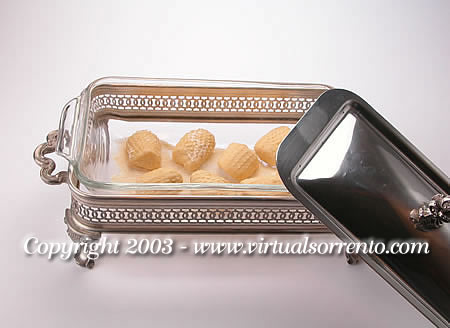The first forms of alimentary pasta
by
(Translated by Marianna Mastro)
![]() t
is not easy to identify the first forms of the Italian pasta, but for the
pasta, which concerns the Campania region, it was very probably the “Ndunderi”,
the “Lagane”, the “Ricci”, which were created
by the inspiration of ancient housewives and handed on from master pasta
makers
or maccheroni makers of the Sorrentine Coast.
t
is not easy to identify the first forms of the Italian pasta, but for the
pasta, which concerns the Campania region, it was very probably the “Ndunderi”,
the “Lagane”, the “Ricci”, which were created
by the inspiration of ancient housewives and handed on from master pasta
makers
or maccheroni makers of the Sorrentine Coast.

The “ndunderi” origin from very far away, and they can be very easily defined the natural descendants of the “polenta caseata di farro” or of the flour kneaded with the curdled milk and the fig-tree milk, worked into small balls and cooked in boiling water. They are produced with a dough made of flour and curdled milk, while in order to make the operation much easier, the curdled milk can be substituted with plain yogurt or sieved cow cottage cheese. The dough is then worked into a rope shaped not too thick or thin and then sliced into small pieces, as one prefers, these pieces are then hollowed by pressing one or two fingers on them according to the size cut.
The “ndunderi” were seasoned with cheese and aromatic spices or with a very appreciated cold dressing made of parsley, garlic, some small fennel leaf, sheep milk cheese, salt, walnuts and extra virgin oil.
During the years, this dish has been subject to many variations and arrangements up to being completely cancelled together with its name with the arrival of the Post Colombian period as we will see further ahead.
The “lagane” is pasta widely present in the entire Campania region. They are produced by a blend of flour, water and salt and then reduced in very thin sheets of pasta with the press ion obtained on the pasta with the “laganaturo” (a cylindrical and smooth piece of wood wide about 4/5 cm. and long 50 cm.) the pasta is then cut in stripes of 1 cm.
The “lagane” as we previously said, can be compared to the modern “pappardelle” and they are very palatable when magnificently combined with a sauce of tender chickpeas boiled for a long time with oil, fresh garlic and plenty of parsley. This dish is eaten as a tradtion on November 2 in order to mitigate the sadness of the day.
The “ricci” is a pasta whose invention is awarded to the master pasta makers of the Sorrentine Coast who were able to wind with a great ability on a thin piece of wire a thin “rope” of pasta obtained by rubbing the dough of flour, salt and water on the “spianatoio”; a round shaped piece of wood on which was blended and worked with great strength of the arms the pasta obtained.
The “ricci” are
compared to the “fusilli” and were
seasoned with the same dressings used for the “ndunderi”.
Exactly like the “ndunderi” they were subject to great transformations
upon the arrrival of the products from the new world.
